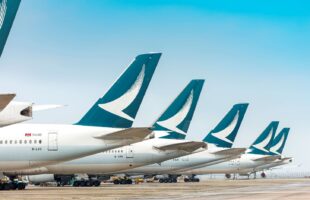

Chengdu Tianfu International Airport or TFU, which started operations last year, now has a fully automated cargo terminal as the airport group is looking to transform TFU into an integrated international transport hub connecting China with Europe, the Middle East, Central Asia and Southeast Asia.
One of the features of the cargo hub are two elevating transfer vehicles (ETVs), installed by Lödige Industries, with a five-level automated ULD storage and handling system for 227 20-ft storage positions. Payload Asia talks to Nicholas Tripptree, managing director of Lödige Industries for Asia Pacific and Australia, to know more about the German company as it makes its move into the region.
Can you give us a brief background about Lodige Industries?
Lödige Industries is the market leader for automated air cargo terminals. The Germany-headquartered company has been active in the air cargo market since the 1970s when it built the first such terminal for KLM in Amsterdam. Key projects since then include the AAT Terminal 2 in Hong Kong, Malaysian Air Cargo terminal in Kuala Lumpur, the IAG world cargo centre at London Heathrow, and more recently Finnair Cool Nordic Cargo Hub, the smartIST cargo terminal at the new international airport of Istanbul, the new dnata cargo warehouses in Frankfurt and in Singapore, and most recently the Chengdu Cargo terminal we just informed about.
Where do you operate, and which key regions is the company looking to expand?
Lödige operates around the world with offices in over 20 countries. Our regional head office for Asia is in Hong Kong and we have offices in Beijing, Kuala Lumpur, Singapore and Sydney. Lödige Industries has been active in Asia for 30 years this year. We have other regional headquarters in the Middle East and North America. Local service teams as well as our central 24/7 customer care centre support our clients around the world with service and maintenance provision.
How big is the demand when it comes to your main products and services?
We have seen steadily increasing demand from airlines as well as ground handlers and forwarders for automated cargo terminals to support delivery to their customers. More recently, amidst Covid-restrictions and the recent intensification of labor shortages in a sector that was already coping with the rise of global e-commerce, we definitely see an uptake in interest for solutions that can ensure service delivery in these conditions. Such a solution is not always a fully automated cargo terminal that can handle hundreds of thousands of tons of cargo, but depending on the requirements of the terminal, can start with mobile equipment such as automated guided vehicles or ‘Flexloaders’ that can assist in the ergonomic and fast building and breaking of containers.
Are there any key verticals or markets that you are focusing on?
It is important to note that the automation software that controls the cargo terminal is just as important as the hardware used. This is a proprietary development for us. Our software solution is based on our more than 50 years of experience in handling air cargo and provides real-life data, monitoring and control of the terminal. While cargo terminals and equipment are definitely a key focus for us, we also have a strong presence in other airport-related services such as catering systems for customers such as Gate Gourmet (Zurich), Cathay Pacific (Singapore) or more recently for Air China in Chengdu. These are essentially full blown catering handling systems that include both the transportation of trolleys, pallets and bins, as well as the cooled storage until meals are required for their flights. These systems also provide full inventory control to caterers, which often is a key requirement for caterers approaching us.
What have you observed amongst airports when it comes to automation?
Automation is both highly desired in the air cargo world, for the reasons mentioned above, the amount of air cargo is growing, turnaround timelines are becoming faster, shipments are becoming smaller and less people are available to work in warehouses, on top of that e-commerce has taught us all to expect to know exactly where shipments are at any given time. At the same time, automation is also often approached with caution, automated terminals are not only a key investment for cargo handlers, they are also drivers for change. Financial concerns are usually short-lived, once the very real and short-to mid-term return on investment is calculated. Planning change in the air cargo industry is much less straightforward, many things we do today in this industry are not much different from 30 years ago. So to plan to change our ways requires more than a financial budget. Our partners have had very positive experience with involving their own staff as well as their customers early on in the process, in order to reap the highest potential benefit for everyone involved.
Which technologies do you think will bring further growth for air cargo?
The growth in air cargo is less due to any technology but enabled by technology. Any automation efforts are going to improve a terminal’s ability to cope with peak flows, schedule changes and further growth. We believe that both labor shortages and cargo growth rates are likely to stay with us. Automating intra-terminal transportation and storage either via automated storage and retrieval systems (ASRS) or flexible and reroutable equipment such as AGVs not only allows airlines, cargo forwarders and handlers to handle these but will improve accuracy, speed and throughput, while increasing the safety of personnel in the terminal.
How much investment is needed, and what’s the potential payoff?
Due to confidentiality agreements we can’t disclose prices, but costs, in any case, very much depend on the requirements of the client, tonnage, number of items, throughput requirements and degree of automation.









